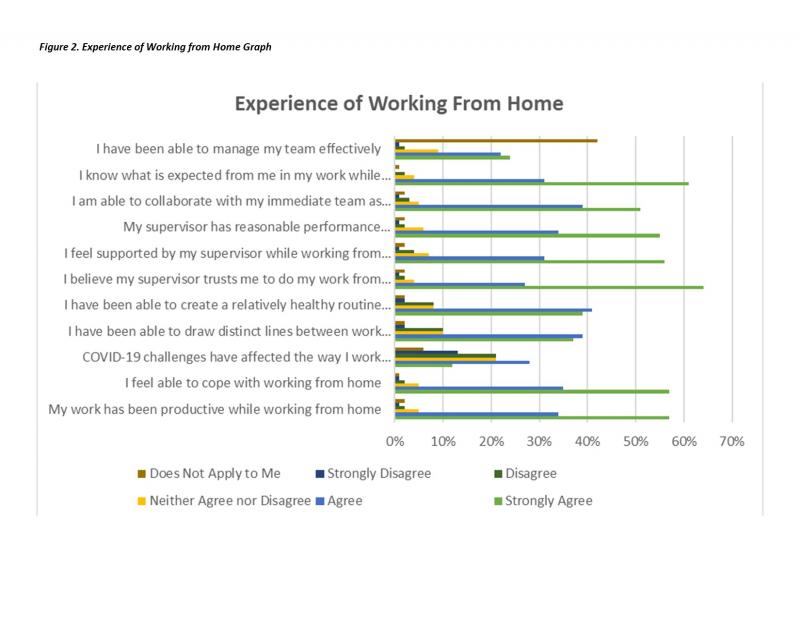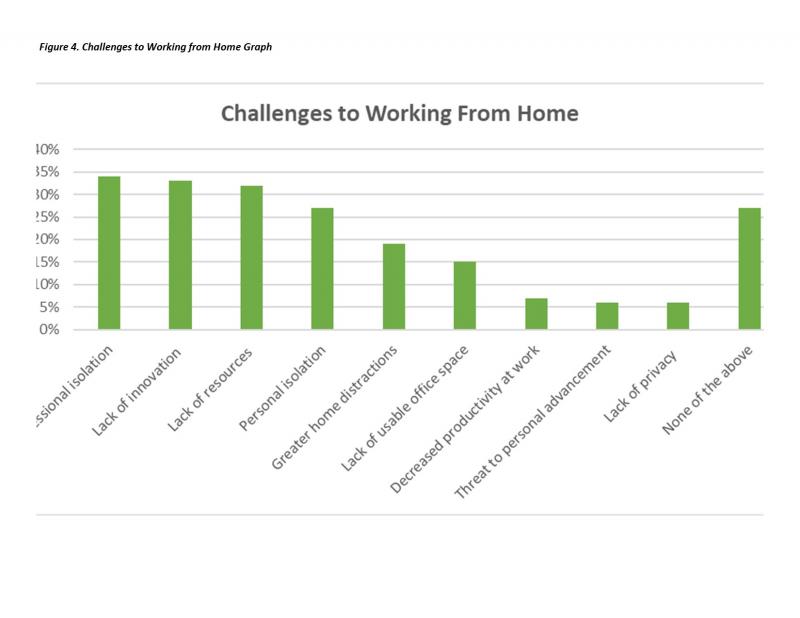Work From Home Survey Results
COVID-19 has affected people in a variety of ways: school closures, restrictions of activities, as well as a large-scale move to work from home (WFH). Research shows there are benefits (e.g., time and money savings) and challenges (e.g., social isolation) to WFH.
To provide a positive work experience, organizations must evaluate the impact of WFH arrangements and work towards enhancing benefits and improving challenges. In 2020, the SHA's Research Department and Organizational Culture department conducted a study to understand how employees are feeling about working from home.
A total of 1,950 SHA employees participated in a comprehensive survey that assessed how they have adapted to working from home.
- Eighty per cent of those surveyed had not worked from home prior to the pandemic
- Of those, 58.4 per cent said they would like to keep working from home full-time
- Some, 33 per cent, said they would like to work from home part-time
- And only 8.5 per cent said they would like to work full-time at a shared office
Although the majority of respondents said they were able to adapt to working from home, the comments showed that the initial transition was often not easy.
“Because working from home was being brought in quickly to try and get people out of the building the process felt a little scattered. There was some delays and miscommunication in getting VPN set up. Each worker was left to determine their own processes. While I appreciated the autonomy and trust, it felt a bit like re-inventing the wheel when figuring out how to do remote patient contact.”
Most people felt their work was productive and they were coping well, working at home. Many were able to draw distinct lines between work life and home life and were able to create a relatively healthy routine.
"I believe I have been more productive working from home than I was in the office as my children are actually less distracting than the in-office distractions and interruptions I used to experience. Removing the in-office micromanagement, tensions, and negativity has also made working for the SHA more enjoyable, I have heard this from others as well and I have been happier with work over the past few months!!”
Staff said it was ideal when they had supervisors who were supportive in the move to WFH.
However, it seems permission to WFH has not been consistent throughout the SHA and sometimes appeared to depend on whether the supervisor was in favour or not.
“Although my job could be done remotely, there was a lot of pressure to come into work, just to be here and all of my team members felt this. Other teams doing similar work have been "mandated" to work from home for their safety. Why is my team pressured to be present when work can be equally achieved off site? I had VPN set up before this. Even though it can kick you out repeatedly, I know how to manage this and can work effectively.”
Benefits of WFH included time and money savings, an improved work environment, improved work-life balance, and improved health.
“I feel so much better physically and mentally. Today, the workplace is not a healthy environment. People are so stressed and bring that to work. I feel so much happier in my home environment and am not bombarded with all the negative chatter. My life is so less rushed and I feel so connected to my family. All in all the most positive experience! Thank-you for the opportunity.”
Although responses to survey questions were generally very positive, some people did experience challenges with WFH, including professional isolation, lack of innovation, and lack of resources.
“I did find it harder to collaborate/consult in the moment, as I could not walk down the hall to chat quickly with a colleague. Instead would have to use email/text/phone and often wait for a reply, which did not always happen in a timely fashion.”
- Studies repeatedly show that autonomy in work is a large predictor of work engagement. Giving employees the option to work from home is likely to result in higher levels of job satisfaction and work engagement.
- Staff say greater flexibility in work hours is highly valued. However, working from home will not suit everyone and will be difficult for some staff to due to the nature of their work. However, many staff clearly desire this and would be pleased to be given the choice to work remotely.
- While the COVID-19 pandemic accelerated the movement towards WFH, there remains uncertainty and skepticism over the long-term use of these practices. Our findings suggest that WFH is a viable and preferred working arrangement amongst SHA employees that would provide benefit to the individual as well as the SHA through increased engagement and reduced use of resources.
- However, it may require a shift in thinking to be seen as acceptable within the organization. This study assessed the experiences of WFH employees, but not associated issues, such as work productivity or difficulties faced by colleagues who remained in the office.
- Future research is needed to gain a holistic picture of the effectiveness of WFH arrangements within the SHA.
Although this survey focused on the effect of WFH on employees, there are also organizational ramifications to this. The SHA workforce has grown but infrastructure has not paralleled in growth, resulting in increasingly smaller workspaces. Having a WFH option is likely to free up valuable real estate and reduce demand on resources.
Additionally, recruitment and retention of rural employees is an ongoing issue as there are lower job application rates for rural positions. Having a WFH option where possible would allow people to live where they choose but still fulfill the responsibilities of the role.
While the COVID-19 pandemic accelerated the movement towards WFH, there remains uncertainty and skepticism over the long-term use of these practices. Our findings suggest that WFH is a viable and preferred working arrangement amongst SHA employees that would provide benefit to the individual as well as the SHA through increased engagement and reduced use of resources. However, it may require a shift in thinking to be seen as acceptable within the organization.
This study assessed the experiences of WFH employees, but not associated issues, such as work productivity or difficulties faced by colleagues who remained in the office. Future research is needed to gain a holistic picture of the effectiveness of WFH arrangements within the SHA.
For more information, contact Research Analyst Fiona Fick.






